As part of our new temporary exhibition “Ingenious inventions – Innovative ideas: Episodes from the history of ancient technology” we are regularly presenting online 2000-year-old innovations in science and technology, and give tips on how those interested can become ancient engineers. At the heart of our fourth episode is Heron of Alexandria's "automobile" and other inventions.
Heron was a jack of all trades from 1st century AD Alexandria, who in all likelihood had access to the books of the greatest library of the ancient world and therefore the works of scientists who had come before him. He was also the inventor of a truly special automatic machine. We could even call it the world’s first automobile prototype, although it did not have any seats. It was, however, “green” and “self-driving”.
The machine is described in the first part of the book on Automatic Theatre, which survived in the original Greek and can be read along with the treatise on Pneumatics in an 1899 edition. The device is essentially a puppet theatre which could roll out in front of an audience. On the top was a circular Greek temple with a statue of Dionysus in the middle and a leopard, his favourite creature, lying next to him. An altar stood in front of the temple, which was surrounded by the statuettes of Bacchantes. A fire flared up on the altar, Dionysus squirted milk from his thyrsus staff and poured wine from his cup as Bacchantes danced around the temple to the sound of drums and bells. Then Dionysus and the statue of Nike atop the temple, too, turned around and the same scene was repeated as a sacrificial fire flared up on the altar on the other side of the temple. The machine, which may look kitschy to the modern observer, involved countless minute devices and experiments based on the study of the laws of pneumatics and mechanics. Of these, we will be concentrating only on the “vehicle” at the base of the machine.
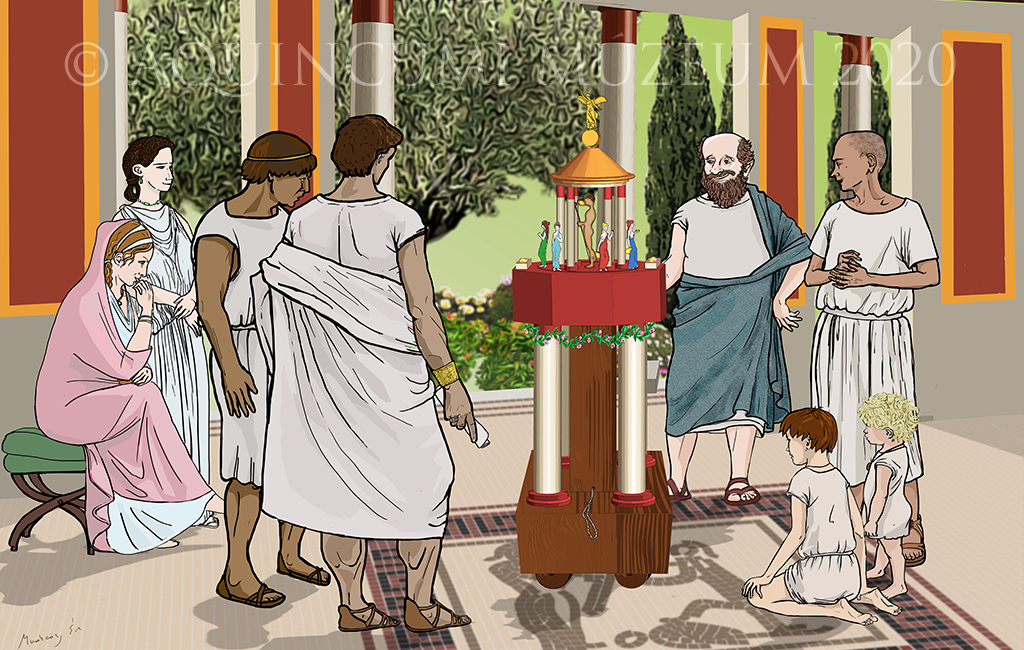
Heron presents the automatic theatre (drawing by Éva Murakeözy)
The base consisted of a box, in which two wheels were attached to an axle which could easily rotate in a socket. On the other, short, side of the box was a third wheel, on a small, also easily-rotating axle. A reel was placed around the larger axle, with which it would rotate together, and a piece of thread was wound around the reel. On top of the box was another one, with a weight at the top. The thread from the reel was brought to the top of the second crate through a pulley and then tied to the weight. The weight was held in place by millet or mustard seeds which filled the top box. If a flap at the bottom of the box was opened the millet or mustard seed fell into a container below, causing the counterweight to descend, which in turn pulled the thread tied to it. The thread wound off the axle, turning the wheels connected to the axle. A more sophisticated way of winding the thread around the axle – half one way, half the other way – could also make the machine go backwards. Heron, furthermore, even came up with a variant which could also turn around.
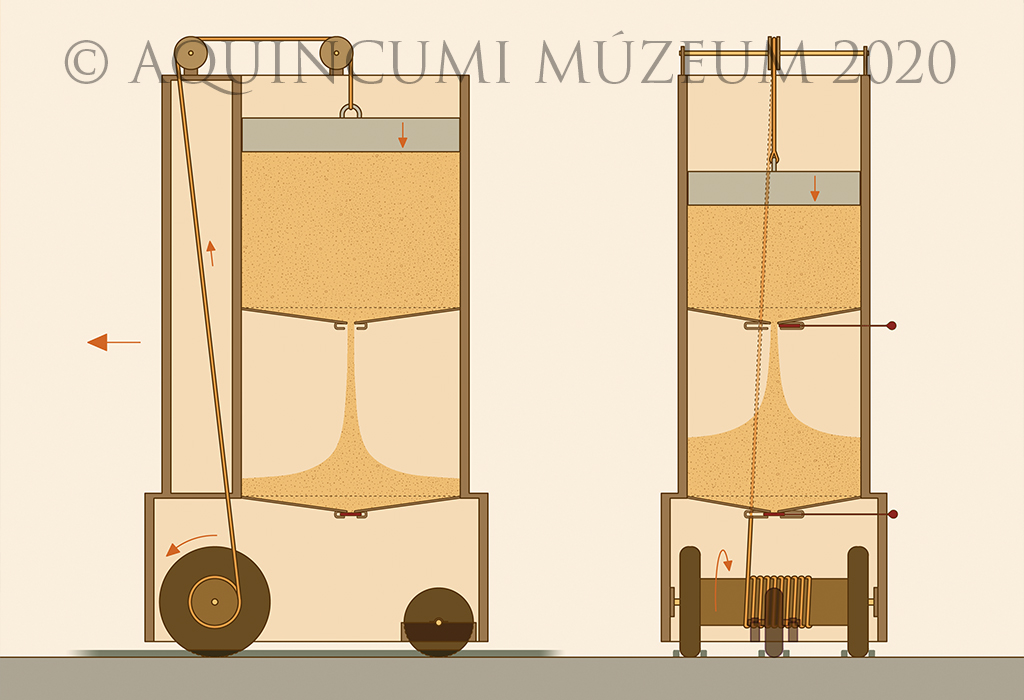
How Heron’s “automobile” works (drawing by Tamás Lajtos based on Heron’s description and illustrations from the 1899 edition)
It, however, would be a mistake to think that Heron wasted his knowledge on just making toys. With these ideas he, in effect, tested the use of alternative sources of energy in an age when industry and technology relied primarily on human and animal power. The first water mills, too, which harnessed the power of water, had barely been built, while Heron made use of expanding air, steam, and even the wind and the sun.
In addition to the books previously presented, his treatise on Mechanics survived in an Arabic translation, which covered the foundations of mechanics as well as pulleys, pulley blocks, sheaves, winches, wedges and their practical use in cranes, levers, presses. He wrote a book on mirrors, in which he also covered the various optical tricks of simple, convex and concave variants. He described an instrument for measuring angles, the dioptra. He also worked on rather practical questions like: how to calculate the number of seats in a theatre, how many amphorae can be loaded onto a ship of a given size and draught, how many tiles are needed to cover a roof of a certain size, or how to calculate the path of a tunnel drilled through a mountain. It is no wonder that interest in his works never faded. As a result, copies of his works were made and much of his writings survived, making him our source for a significant part of ancient technological knowledge. The writings of such a multitalented scientist with extraordinarily diverse interests presumably also attracted avid readers like Leonardo da Vinci and Galileo Galilei.
How does it work?
Automatic temple door opener
The following machine is described in Part I Chapter XXXVIII of Heron’s book on Pneumatics. There is an altar in front of a temple. If a fire is lit on the altar, the temple doors open. If the fire goes out, the doors close.
A wide tube is fed through the altar. The closed top of the tube is still within the altar, while the bottom opens into a closed sphere. Soldered into the sphere is a bent pipe which ends in another vessel. The spindle of each door is extended downwards, turning around a small pivot on a foundation. Two chains are wound around the door spindles. One of these chains holds, through a pulley, the vessel into which the bent pipe goes. Another chain is wound around the spindles the other way around, which holds, through another pulley, a lead counterweight. The spherical vessel is filled halfway with water through a small hole, which is then closed. When a fire is lit on the altar, air in the tube inside it heats up and expands, pushing the water from the sphere through the bent pipe into the suspended vessel. Becoming heavier due to the water, the vessel goes down and, through the chain tied to the spindles, causes the door to open. When the fire goes out, the air cools down, the water flows from the suspended vessel through the bent pipe that reaches its base back into the sphere, the suspended vessel goes back up, and the chain wound around the spindles closes the doors.
Heron’s automatic temple door opener (animation by Áron Fodor based on Heron’s description and drawing and the Kotsanas Museum’s model)
Become an ancient engineer!
Heron’s fountain
In Part I Chapter X of his Pneumatics Heron described a fountain in which the water spurts on its own. We found a modern DIY “home fountain” variant online. We’ve used that to create our own model.
What we’ll need is 3 plastic bottles with their caps, seven drinking straws, a glue gun, a sharp knife, a pair of scissors, and maybe a drill. Kids, ask your parents for help!
Carefully drill into two caps a large hole big enough for two straws to fit. (Fig 1.1.) Glue the two caps together by the top. (Fig 1.2.) Drill two smaller holes into the third cap, big enough for one straw to fit in each. (Fig 1.3.) Cut off the top of one of the bottles, so that you get a funnel. (Fig 1.4.)
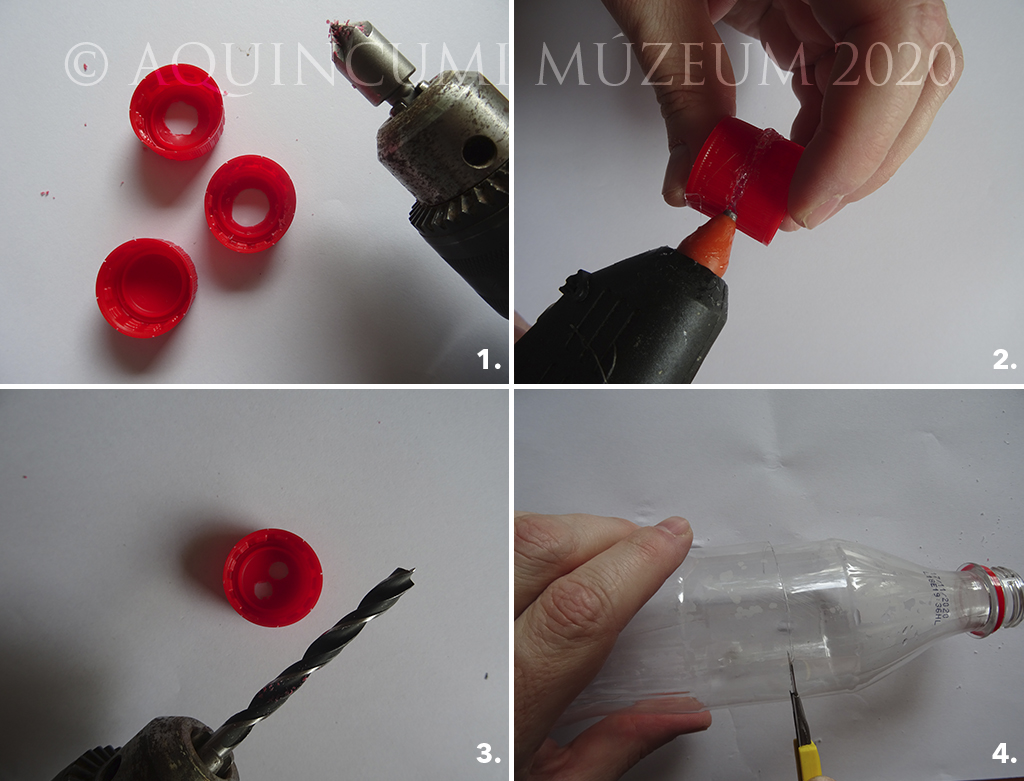
Make your own Heron’s fountain, Fig 1.
Drill or cut a hole, slightly smaller than a cap, in the bottom of the other bottle and glue the cap with two drilled holes over this hole. (Fig 2.1.) Cut off the bendy bits on all but one of the straws. Glue the straws together, slightly incising the end of one straw and sliding the straws into each other, carefully fixing them in place using e.g. duct tape. Make three units of drinking straws of around 45 cm, 25 cm, and 30 cm. The straw with a bendy bit should be in one of the units with two pieces. (Fig 2.2.)
And now it’s time to assemble the parts! Take the bottle with the cap glued on its bottom, screw the double cap on this bottle’s neck and screw the funnel into the cap on the bottom. (Fig 2.2.) Place into the hole of the double cap the triple straw unit and the double straw unit without the bendy bit. Make sure that they are in the correct position, then glue them in place from both sides of the double cap. (Fig 2.3.) Place the third straw through the funnel into the cap with two holes, and carefully glue it in place. Be careful and make sure that the glue gun doesn’t melt the straws. (Fig 2.4.)
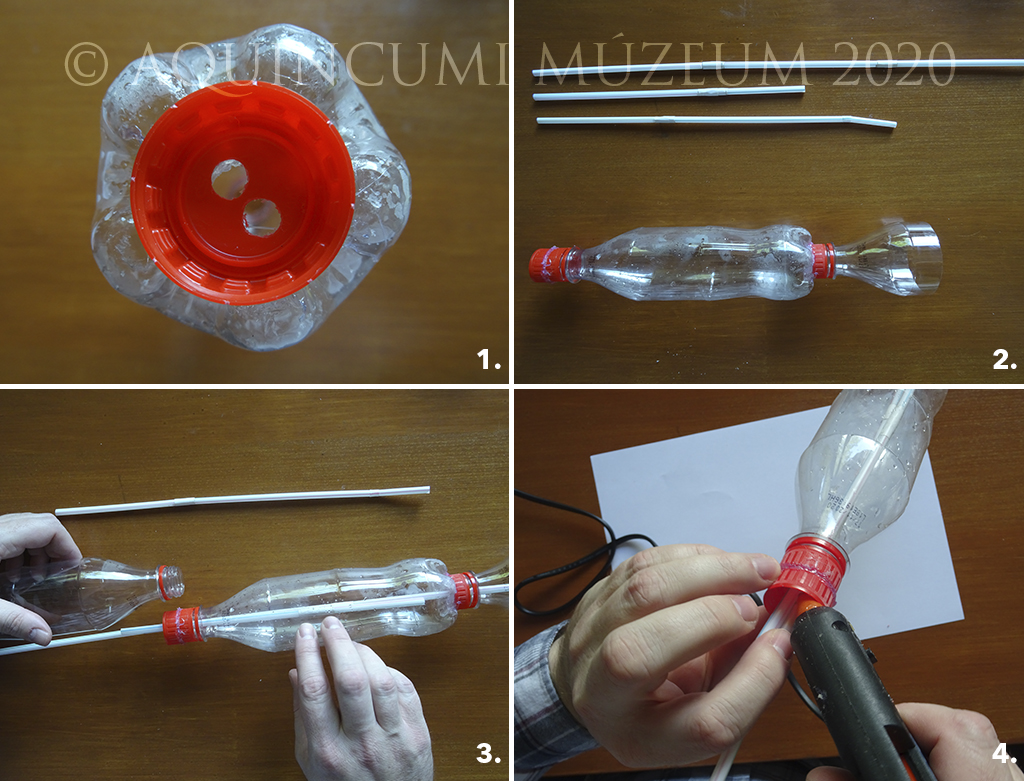
Make your own Heron’s fountain, Fig 2.
Here comes the fun part! Place the fountain the funnel side up. (Fig 3.1.) Pour water into the funnel. (Fig 3.2.) Once the water has flowed into the bottom bottle, turn the whole contraption upside down so that the water flows into the middle bottle. (Fig 3.3.)
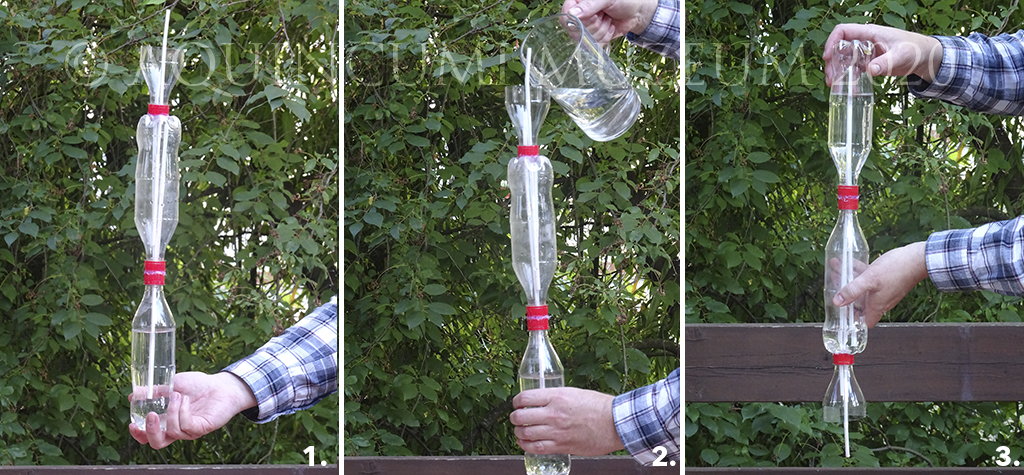
Make your own Heron’s fountain, Fig 3.
Turn it back up and pour water again into the funnel. (Fig 4.1.) Water will spurt from the topmost drinking straw and the fountain begins to work! (Fig 4.2.) Water will spurt until there is water left in the middle bottle. The fountain will stop working when all the water has flowed into the bottom bottle. (Fig 4.3.)
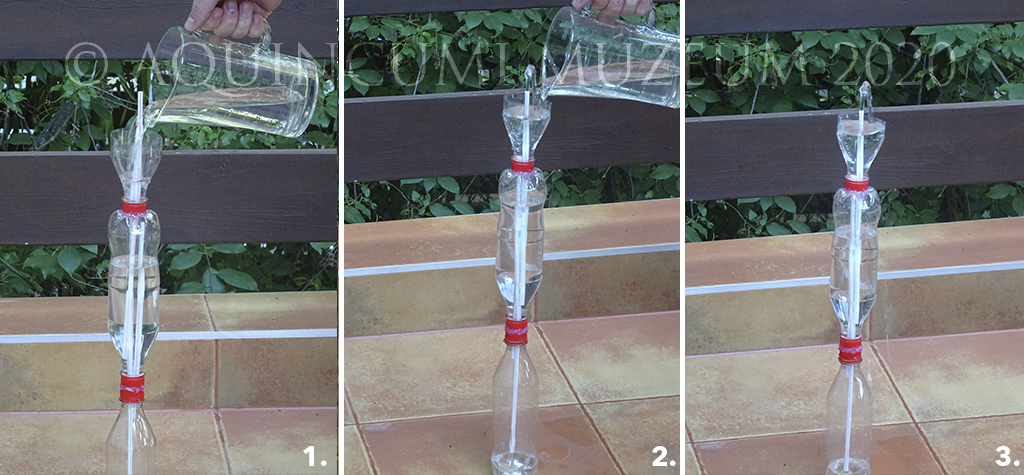
Make your own Heron’s fountain, Fig 4.
Attention! The device will only work if all steps are followed precisely and the sealant is correctly applied everywhere (so please wait patiently until the glue dries and sets). If something goes wrong, don’t worry and try it again! (We didn’t succeed the first time around, but it’s really worth it to keep at it.)
The fountain model was made by István Németh, who also helped me with the description of the experiment.
A DIY Heron’s fountain in operation
Written by Dr Gabriella Fényes
Click here to read the other entries of our online exhibition.


